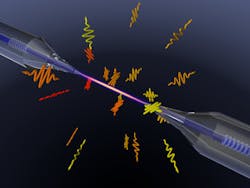Subwavelength-diameter optical fiber shows deviation from Planck’s law for thermal radiation
| Schematic depiction of the Vienna University of Technology experiment. (Image: Vienna University of Technology) |
Vienna, Austria--Experimenters at the Vienna University of Technology have studied the thermal radiation emitted by an optical fiber that has a diameter smaller than the thermal wavelength. They determined that, unlike all objects that are greater than a wavelength in size, the subwavelength fiber's behavior did not follow Planck's law, which normally results in a very accurate description of thermal radiation emission.
The new results, which agree with a theoretical model that takes the emitter shape and size relative to the emission wavelength into account, are important for heat management of nanodevices, as well as for aerosol science.
The researchers combined a fundamental model of the fiber’s structure with experimental measurements of the fiber's optical path length to determine the fiber's change in temperature over time, which allowed the amount of thermal radiation emitted over time to be calculated.
Fluctuational electrodynamics
Researchers Christian Wuttke and Arno Rauschenbeutel sent light through 500-nm-diameter optical fiber and measured the amount of optical energy converted into heat and subsequently radiated away into the environment. "We could show that the fibers take much longer to reach their equilibrium temperature than a simple application of Planck's law would suggest," says Rauschenbeutel.
As for use in aerosol science: "The thermal radiation of a lump of coal can be described perfectly well by Planck's law, but the behavior of soot particles in the atmosphere can only be described with a more general theory, which we could now further confirm in our experiment," says Rauschenbeutel.
The results of the research project were published in Physical Review Letters.
